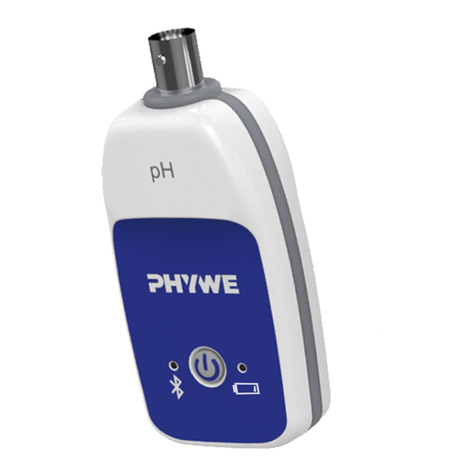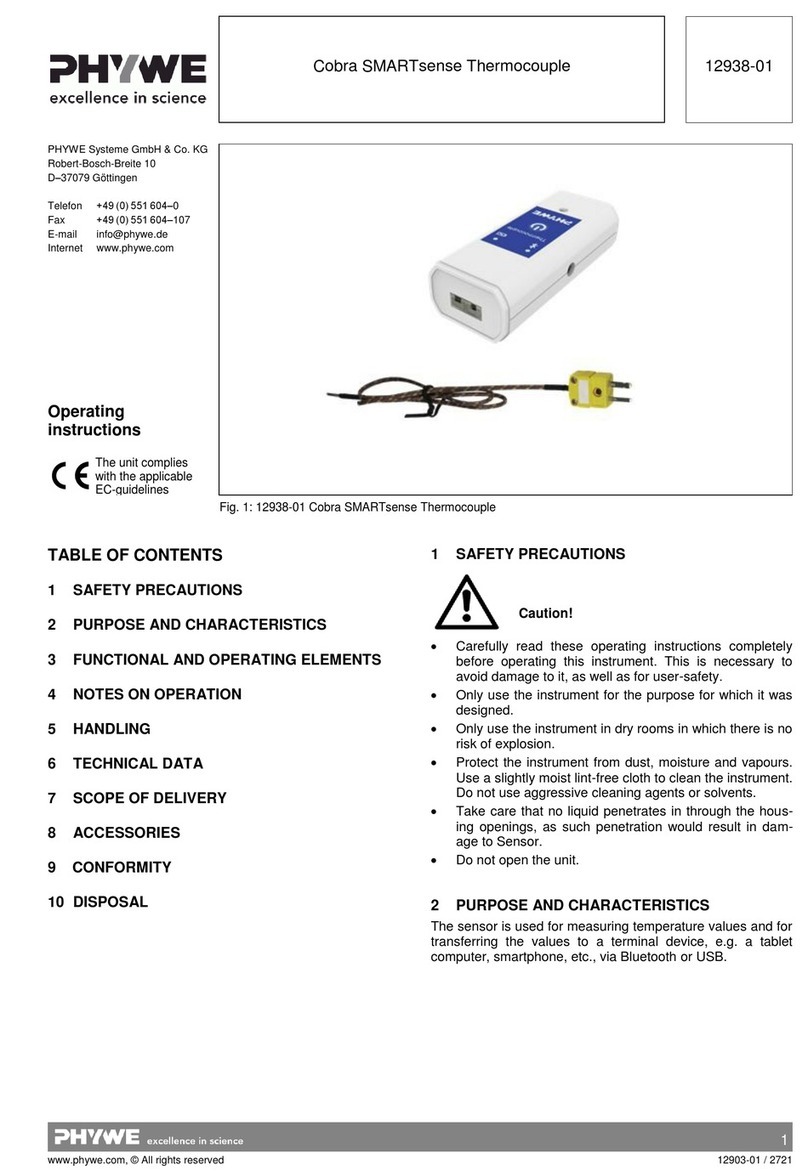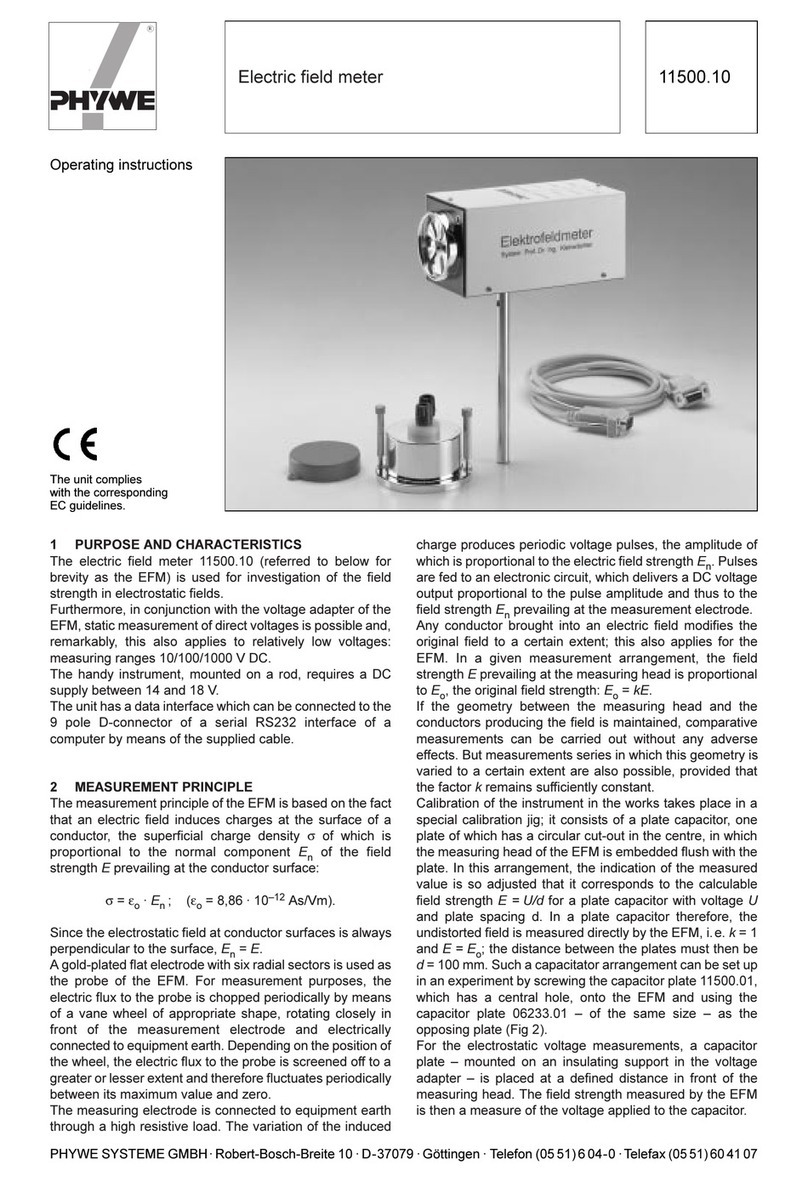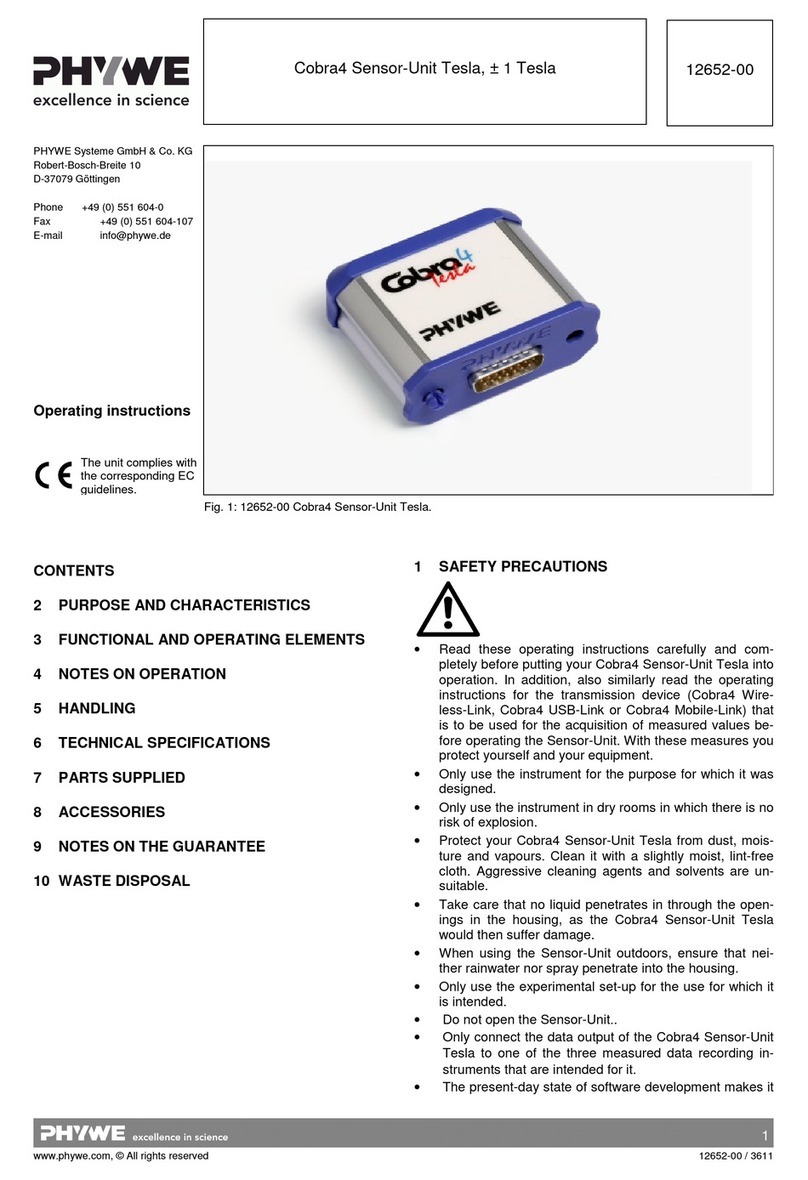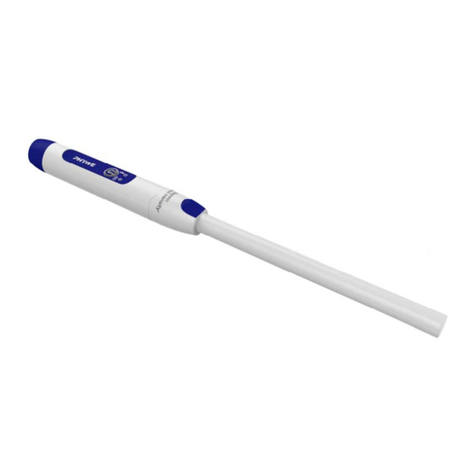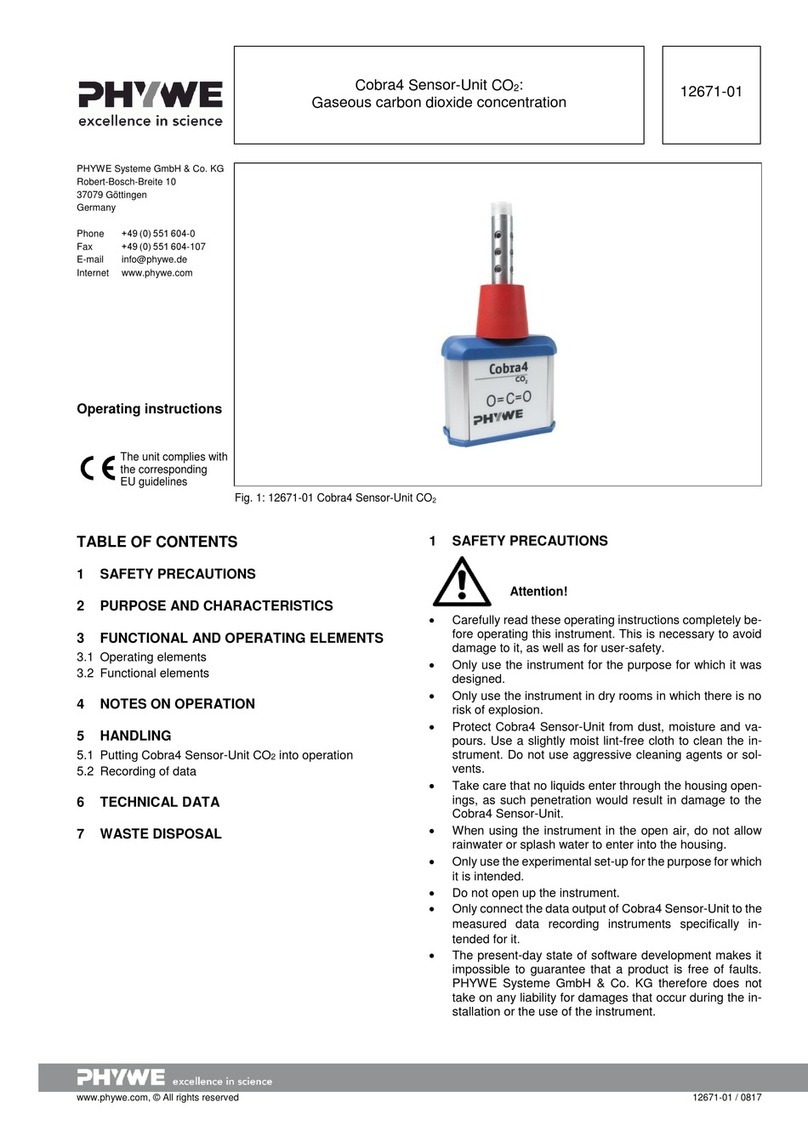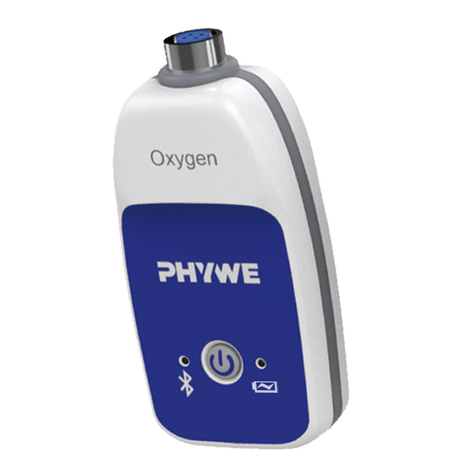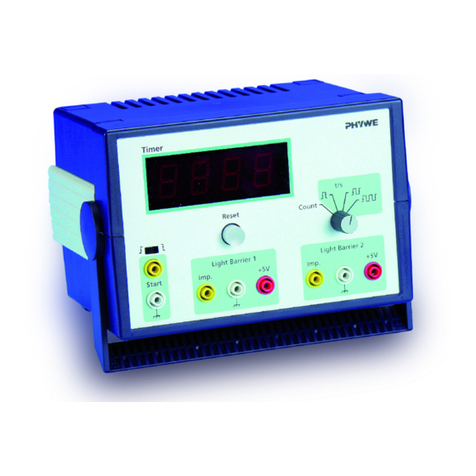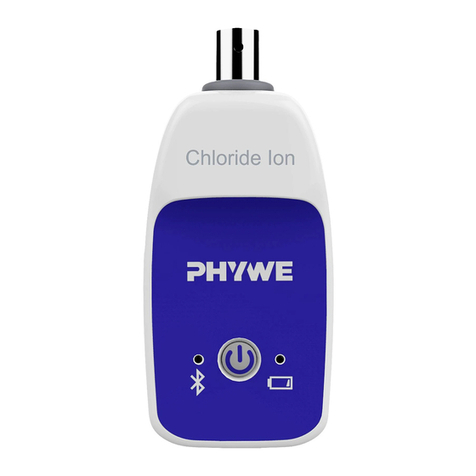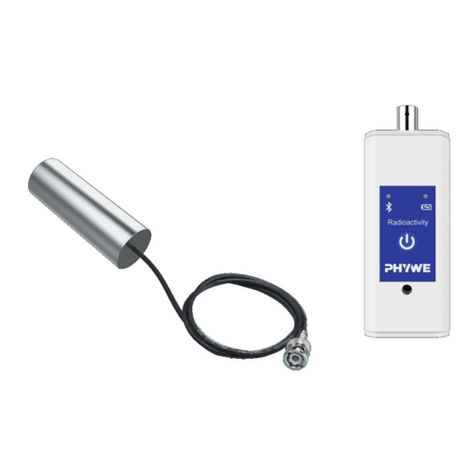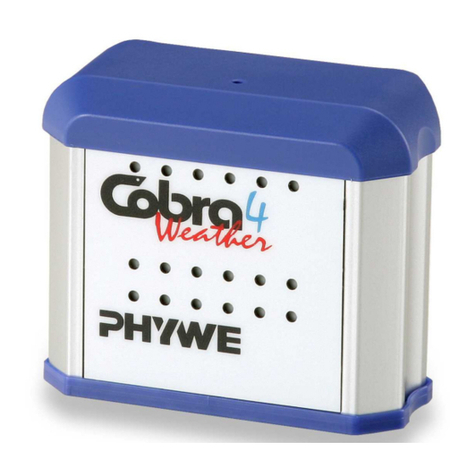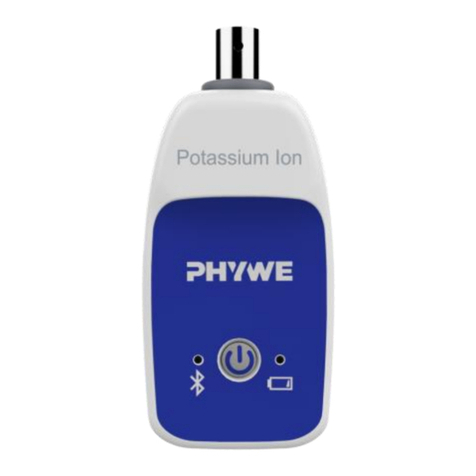
2
www.phywe.com, © All rights reserved 12632.00 / 4808
2 PURPOSE AND CHARACTERISTICS
The Cobra4 Sensor-Unit Conductivity+, Conductivity / Tem-
perature Pt1000 serves to measure conductivity values in
aqueous solutions as well as to measure their temperatures.
According to the type of application, this Cobra4 Sensor-Unit
can be connected to the following measured value recording
instruments for transmittance of measured values to them:
• a Cobra4 Wireless-Link (12601.00) for data transfer to a
computer by wireless,
• a Cobra4 USB-Link (12610.00) for data transfer to a com-
puter via a USB-cable,
•
a handheld Cobra4 Mobile-Link instrument (12620.00
).
The interface to a measured data recording instrument is at
the front of the Sensor-Unit, whereby a mechanically secure
click connection is ensured by the mushroom-shaped click-on
connector and a hole.
The Sensor-Unit is equipped with a five pin DIN socket
("MAB socket") for the connection of sensing units. A com-
bined conductivity-temperature electrode Pt1000 (13701.01)
with DIN plug ("MAB plug") is usually used for the measure-
ment of conductivity values. With this, the conductivity and
temperature of the test solution can be simultaneously meas-
ured.
An adapter for conductivity measuring cells with 4 mm
socket / DIN plug (13701.02) enables a conductivity measur-
ing cell with 4 mm plug (18151.02) or a Pt1000 temperature
probe with 4 mm plug (13702.01) to be connected to the
Sensor-Unit.
Should only temperature measurement be required, then a
temperature immersion probe of type Pt1000 with DIN plug can
be connected (12123.00). A list of sensors (conductivity,
temperature), that can be connected to this Sensor-Unit is
given in section 8 (Accessories).
3 FUNCTIONAL AND OPERATING ELEMENTS
3.1 Operating elements
Cobra4 Sensor-Unit Conductivity+, Conductivity / Tempera-
ture Pt1000 has no elements for manual operation. Operation
is carried out via the hand-held Cobra4-Mobile-Link or via the
computer when Cobra4-USB-Link or Cobra4-Wireless-Link
are used. Operation can be started as soon as connection
has been made between Cobra4 Sensor-Unit Conductivity+,
Conductivity / Temperature Pt1000 and one of the three
measured value recording instruments.
3.2 Sensor interface
The measured values for conductivity and temperature can
be read out from the Sensor-Unit at a maximum speed of 1
measurement per second (1 Hz). As for all other settings,
setting of the measurement frequency wanted for the re-
cording of measured values is made via the particular instru-
ment connected to record measured values.
4 NOTES ON OPERATION
This high-quality instrument fulfils all of the technical re-
quirements that are compiled in current EC guidelines. The
characteristics of this product qualify it for the CE mark.
This instrument is only to be put into operation under special-
ist supervision in a controlled electromagnetic environment in
research, educational and training facilities (schools, universi-
ties, institutes and laboratories).
This means that in such an environment, no mobile phones
etc. are to be used in the immediate vicinity. The individual
connecting leads are each not to be longer than 2 m.
The instrument can be so influenced by electrostatic charges
and other electromagnetic phenomena (HF, bursts, indirect
lightning discharges) that it no longer works within the given
specifications. Carry out the following measures to reduce or
eliminate the effect of such disturbance:
Ensure potential equalization at the PC (especially with Lap-
tops). Use screening. Do not operate high frequency emitters
(e.g. radio equipment or mobile radiotelephones) in the im-
mediate vicinity. When a total failure of the instrument occurs,
unplug it and plug it back in again for a reset.
5 HANDLING
This section describes how to use the Sensor-Unit and re-
cord force data. To avoid failure or improper operation,
please read carefully through this section.
5.1 Putting into operation
Please make sure that the current version of measure is in-
stalled on your PC.
Download free of charge via:
www.phywe.com … software … measure
measure main program
measure module Cobra4
Alternatively, the software update can be performed with the
measure DVD.
Connect your Cobra4 Sensor-Unit Conductivity+, Conductiv-
ity / Temperature Pt1000 to one of the three possible meas-
ured value recording instruments via the 15-pin plug connec-
tor. Connect a conductivity-temperature probe Pt1000
(13701.01) or a temperature probe (12123.00) to the six pin
DIN socket of the Sensor-Unit. The Cobra4 Sensor-Unit is
then immediately ready to start as the connected measure-
ment recording instrument supplies the required voltage.
More detailed information on the steering of measured value
recording is given in the operating Instructions supplied with
the measured value recording instruments Mobile-Link, USB-
Link and Wireless-Link.
5.2 Recording of conductivity values
To measure the conductivity of a test solution, dip the meas-
uring head of the conductivity measuring cell completely into
the solution. For measurements on a series of solutions, start
with the one that has the lowest conductivity if possible. The-
re is always a certain carry-over of solution from one test
solution to the next, so that this procedure keeps possible
errors to an acceptable amount, as the carrying over of a
trace of a weakly conducting solution to a more strongly con-
ducting solution leads to a smaller relative error than the
other way round.
In each case, on changing from one solution to the next, the
measuring head and the electrodes must be rinsed with pure
water (demineralized or distilled).
When absolute conductivity values are to be recorded, then
the cell constant of the probe must be previously determined
using a calibration solution of known conductivity (e.g. with
calibration solution 1413 µS/cm (25°C), (47070.02)). The
value of this cell constant is then to be entered in the appro-
priate position in the measurement recording instrument. The
value of the temperature coefficient of the solution to be
measured should also to be entered there and temperature
compensation is to be triggered there. If a conductivity meas-
uring cell with integrated temperature sensor (e.g. 13701.01)
is used, temperature compensation of the measured values
can be made automatically by activating the appropriate func-

